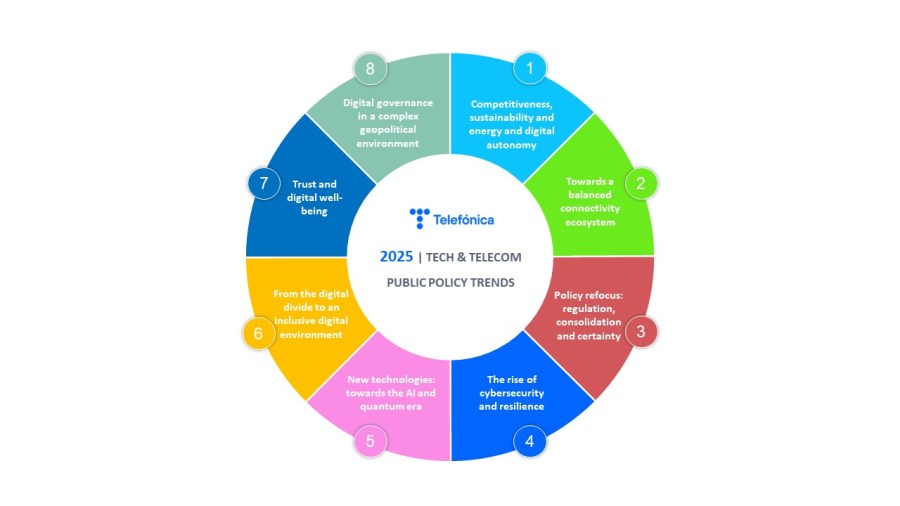Digital innovation and emerging technologies are transforming the foundations of economic development and welfare globally, highlighting the need for societies to adapt to this evolution. In this context, policymakers and regulators are key to creating frameworks that facilitate full integration into the digital age.
Continuing the series of trends we started in 2023 and 2024, we invite you to discover the top 8 issues for 2025 in the field of public policy related to technology and telecommunications:

1. Competitiveness, sustainability, energy and digital autonomy
2025 will be a key year to test Europe’s implementation of the announced policies on competitiveness, sustainability and autonomy. In 2024, Letta and Draghi urge in their reports a new industrial strategy for Europe, highlighting its lagging innovation and competitiveness, and pointing to telecommunications and digital innovation and defence as key areas to improve productivity, resilience and single market integration.
Based on their recommendations, the European Commission 2024-2029 has outlined in its mission letters a roadmap to strengthen Europe’s tech capacity and revitalise its industry, with the Single Market as a central pillar. To this end, Europe should prioritise the creation of a favourable environment for investment, innovation and the diversification of strategic partners in challenging geopolitics.
In the digital domain, the mandates of Henna Virkunnen, Teresa Ribera and Valdis Dombrovskis will be key. Their priorities, which the European technology sector welcomes with optimism, include regulatory simplification, fostering innovation and investment in ultra-broadband networks and emerging technologies such as AI and cloud computing, as well as creating the conditions that allow businesses to gain scale and operate in a secure and resilient digital environment. In this framework, mobilising investment for a sustainable digital transition could leverage green finance and taxonomy.
In 2025, the EU will commit to a pact that combines competitiveness, sustainability, energy and digital autonomy, ensuring resilience, well-being and growth beyond 2030.
2. Towards a balanced connectivity ecosystem
Digital innovation and the growing demand for data has transformed connectivity into a connectivity ecosystem. This ecosystem comprises a wide range of actors, beyond telecoms, and interconnected elements that facilitate communication between devices, fixed and mobile networks, satellites, data centres, submarine cables, and platforms and applications.
Interdependence and cooperation between different actors are and will be key. These actors will have to work together to build a common future based on more resilient and advanced digital infrastructures. This gives rise to the concept of 3C networks: Connected, Collaborative and Computational. Service virtualisation and migration to the cloud are central to this transformation, for greater flexibility and efficiency. Open Gateway’s apificationmodel, also illustrates this change.
Operators, as the main investors, will remain key to achieving the Digital Decade 2030s goals, especially through the development of appropriate spectrum policies, including mid-bands and the 6 GHz band, while ensuring policies that enable investment and allow their economic sustainability. However, the entry of new players has enriched the ecosystem, but has also generated regulatory challenges, especially in terms of fair competition, interoperability and tech sovereignty that will need to be addressed.
3. Policy refocus: regulatory simplification, consolidation and certainty
Competitiveness is a key priority for 2025, which will require a profound and strategic overhaul of the regulatory and competition framework. In Europe, it must materialise in a digital networks act with a holistic vision that, in addition to simplifying regulation, drives innovation – in the face of the paradoxes of open internet regulation, encourages investment, and addresses artificial imbalances. Regulatory certainty will be essential in Latin America, as well as greater regulatory flexibility and efficiency with examples such as A2P messaging.
Market structures must be able to adapt to competitive challenges. Although in Europe, the Commission missed a chance in the Orange/Más Móvil merger, it now has the opportunity to adapt to new dynamics, to make competition policy an instrument to foster European competitiveness in a new pact for competitiveness, competition and consumer welfare.
4. The rise of cybersecurity and resilience
Improving cybersecurity and resilience, or continuity of service, will be key in 2025 in the face of increasing digitalisation, technological sophistication, including the use of AI, and geopolitical tensions. Companies will need to integrate standards, adapt to multiple certifications and protect supply chain security as incidents increasingly transcend company boundaries. Cybersecurity liability already extends to the board level and could have a high financial impact.
Critical infrastructure protection, including the security of 5G networks, will be central. Reliable telecom operators are key players in cybersecurity, because of their infrastructure, capabilities and reach. However, their contribution will depend on ensuring their economic viability.
In 2025, Europe will face a complex regulatory framework, a sea of acronyms, including NIS2, DORA, CRA, CSA and CER. Europe faces the challenge of simplifying, prioritising international standards, proportionality, coherence, efficiency and coordination between authorities and with companies. In addition, it will need to strengthen the industrial base through investment, training, cybersecurity culture, specialised talent, and stronger international cooperation against global cybercrime.
Latin America, with less maturity in regulation and business practices, can move forward by following examples such as Chile, which in 2024 addressed the Cybersecurity Framework Law, as well as by building on best international practices.
5. New technologies: towards the age of AI and quantum computing
The development of artificial intelligence (AI) and its adoption by companies in all sectors will continue to be the focus of technology and public policy in 2025, when some regulations, such as the European AI Act, will start to be implemented. The challenge will be to combine the promotion of technological innovation with social responsibility and the deployment of a balanced competitive framework, including the development of standards.
There will be a renewed focus on augmented reality, advances in virtualisation, cloudification, andapification, as well as the use of AI for the networks of the future, the start of 6G development, and the anticipation in network resilience with quantum-safe technologies. And interest in quantum technologies will increase in 2025.
6. From the digital divide to creating an inclusive digital environment
Digital inclusion is not just a technological challenge, but also a human one. Closing the coverage gap is essential, but equally fundamental is overcoming the usage gap, in order to take full advantage of the potential of the technologies available to society.
While initiatives such as network sharing in regions such as Latin America have been key to closing the coverage gap, especially in rural areas, the digital divide may persist in the form of the usage gap. Moving from the coverage gap to the usage gap will require a rethink of public policies for digital inclusion to foster the demand, adoption and use of digital technologies.
This evolution will require a comprehensive approach that combines infrastructure, digital education and inclusive policies, steering the debate towards fostering initiatives that promote an inclusive digital environment. In other words, an approach that addresses the digital divide, in particular the usage gap, and integrates all actors into the digital economy: individuals, businesses of all sizes, public institutions, entrepreneurs and employees.
7. Trust and digital well-being
The growing importance of trust and digital well-being suggests that in 2025 policies will need to be reoriented towards a holistic approach that protects not only users, but also society as a whole in the digital environment.
As technology advances, its impact on key areas of daily life such as education, health or employment grows, increasingly affecting well-being. Therefore, the challenge of achieving safe and reliable digital inclusion will depend on policies that close usage gaps, addressing key issues for well-being such as data protection, disinformation, cybercrime, the fight against fraud, the development of digital identity, the ethical use of emerging technologies such as AI or the protection of minors.
Last, investing in connectivity means investing in welfare, as the deployment of ultra-broadband networks, as a basis for social and economic development, facilitates digital inclusion and the digitisation of services, including public services, as well as new technologies that enhance service quality or create new innovative use cases in all sectors for the benefit of society.
8. Digital governance in a complex geopolitical environment
2024 has been an election year, with significant changes that will affect 2025, the start of which will coincide with the beginning of a new political cycle in the EU and the US, in a complex geopolitical environment. The transatlantic relationship and new agreements such as the EU-Mercosur will be key to addressing global challenges such as digitalisation and sustainability, promoting common values and tech leadership and diversification.
In 2024, international fora such as the OECD Global Technology Forum and the World Telecommunication Standardisation Assembly highlighted the importance of common standards for technological development without fragmentation. For its part, the UN Summit of the Future, through the incorporation of the Global Digital Compact into the Pact for the Future, is committed to strengthening multilateralism and advocating for an inclusive and sustainable digital future. Similarly, events such as WSIS+20, the IGF and the B20 underlined the importance of bridging divides and building a more connected, equitable and collaborative global future.
The development of new technologies such as AI and the issue of resilience pose challenges in the development of ethical global governance and balanced, interoperable regulations.











